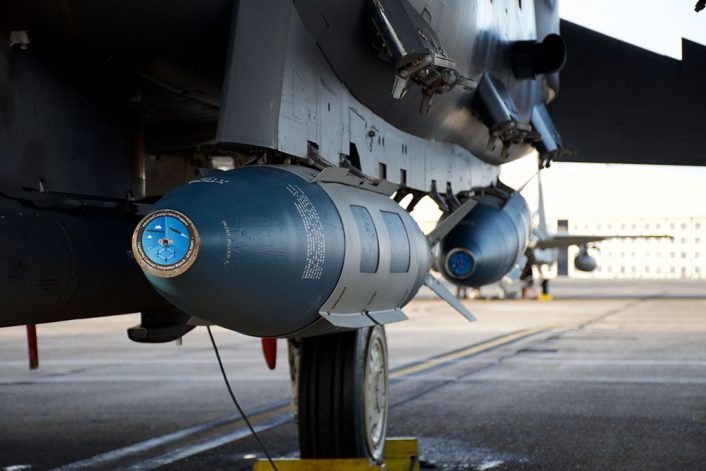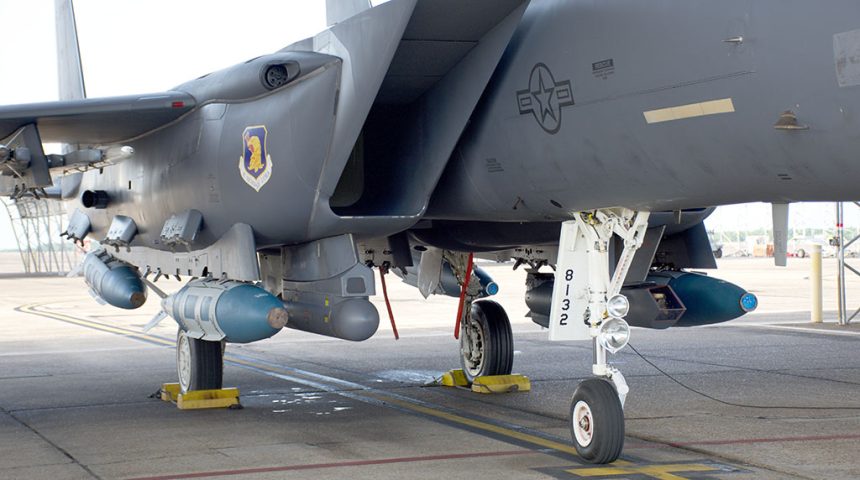Tests with the GBU-31 pave the way for the use of Joint Direct Attack Munitions against “moving and static maritime targets”.
Three F-15E Strike Eagles from the 85th Test and Evaluation Squadron carried out tests with modified 2,000 GBU-31 JDAMs on Aug. 26, 2021.
According to the 53rd Wing, partnering with the Air Force Research Laboratory, the F-15E crews developed and demonstrated new tactics, techniques, and procedures for employing modified GBU-31s on both moving and static maritime targets. The goal of the testing was “to validate a new way to employ air-delivered munitions on ships that will change the maritime target lethality paradigm.”
“For any large moving ship, the Air Force’s primary weapon is the 2,000-pound laser guided GBU-24,” said Maj. Andrew Swanson, 85th TES F-15E weapons system officer in a public release. “Not only is this weapon less than ideal, it also reduces our survivability based on how it must be employed. This munition can change all of that.”
JDAM is a guided air-to-surface weapon that can use several different warheads: the 2,000-pound BLU-109/MK 84, the 1,000-pound BLU-110/MK 83 or the 500-pound BLU-111/MK 82 warhead as the payload. Guidance is facilitated through a tail control system and a GPS-aided INS. The navigation system is initialized by transfer alignment from the aircraft that provides position and velocity vectors from the aircraft systems.
The GBU-31s in the photographs released by the U.S. Air Force appear to be GBU-31(V)1/B, using the guidance kit on an MK-84. It would be interesting to learn a bit more about the “modification” mentioned in the public release and how the JDAMs were used to engage “moving maritime targets” as JDAMs are not Laser Guided (unless they are Laser JDAMs – mentioned later) hence more suitable for use against fixed/stationary targets.

LGBs (Laser Guided Bombs) have long been used in maritime scenarios for moving targets but the seeker head of the LGB can be adversely affected by the elements (such as bad weather, fog, smoke, etc), potentially reducing its effectiveness. These weapons use on-board seeker to track targets that are designated by laser, typically in the infrared spectrum, and adjust their glide path to accurately strike the target.
Since the weapon tracks a light signature, not the object itself, the target must be illuminated from a separate source: either by ground forces, by a pod on the attacking aircraft or a different support aircraft (performing the so-called “buddy lasing”). While some LGBs, have been upgraded to embed a backup GPS guidance, the GBU-31s use only GPS coordinates to autonomously navigate to the designated target coordinates. Target coordinates can be loaded into the aircraft before takeoff, manually altered by the aircrew before weapon release, or automatically entered through target designation with onboard aircraft sensors. In its most accurate mode, the JDAM system will provide a weapon circular error probable of 5 meters or less during free flight when GPS data is available. If GPS data is denied, the JDAM will achieve a 30-meter CEP or less for free flight times up to 100 seconds with a GPS quality handoff from the aircraft.
Laser JDAM adds a laser seeker to the nose of a JDAM-equipped bomb, giving the ability to engage moving targets to the JDAM. For example, GBU-56(V)2/B is an MK-84 2,000-lb bomb fitted with the DSU-40/B semi-active laser (SAL) and KMU-556/B guidance set.
Anyway, building on a previous 53rd Wing test conducted last year (where the B-52H Stratofortress from the 49th TES dropped JDAMs in order to assess the viability of specific maritime impact conditions), the latest testing activity was carried out as part of the QUICKSINK Joint Capability Technology Demonstration, whose aim is to develop a low-cost method of achieving torpedo-like seaworthy kills from the air: a U.S. Navy submarine has the ability to launch and destroy a ship with a single torpedo at any time, but by launching that weapon it gives away the location of the vessel.









